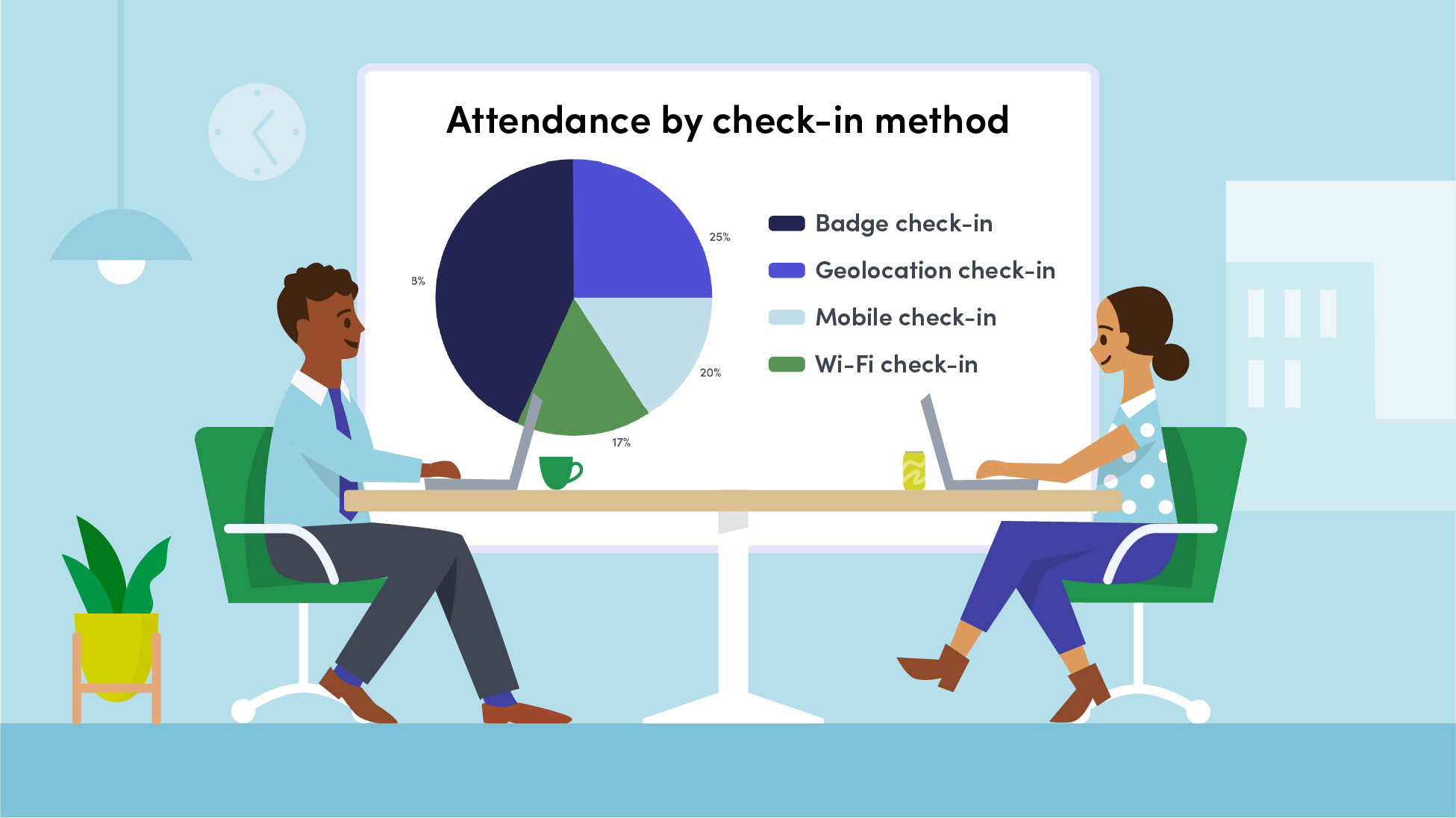Collecting work attendance data is rapidly becoming a standard practice—in fact, 8 in 10 companies will look at office attendance data in 2024. To gather this data, companies are currently using a few different methods. A recent survey found 66% of organizations are using a tool to measure this, such as access control/badge systems or a workplace management platform.

With the access control method, every time an employee scans their badge or phone to enter the office, their attendance for the day is noted. Some companies also opt to use a workplace management platform or Wi-Fi network access to measure onsite attendance.
On the other hand, 17% shared that onsite attendance is manually reported by employees. Another 17% reported that onsite attendance is now tied to employee work performance.
Why do employers want attendance data?
The popularity of hybrid work models has made it increasingly challenging for organizations to access the data they need to make decisions about their spaces and employees. For the 91% of organizations who envision their workplace as hybrid or fully onsite five days a week in the future, accurate data helps in the following ways:
1. See who’s onsite at a given time for security + compliance
Understanding who is in your space at any given time is crucial information from a security and compliance standpoint. For California employers in particular, Senate Bill 553 imposes new safety obligations that make having real-time access to this data an essential part of your security protocols. In the case of an emergency, this information enables your security team to ensure that everyone’s accounted for and can receive the information they need in a timely manner.
2. Measure success of return-to-office (RTO) efforts
With more companies encouraging or even mandating their employees to work onsite this year, attendance data lets them see if their efforts are working. Especially for those employees whose onsite attendance is tied to their work performance, having an accurate data source to show they’re in compliance with their company policies is crucial. For the 17% of organizations relying on manually reported attendance data from their employees, not only does this create extra steps for employees to input that data, but it also leaves the entire process open to the potential for human error. Democratizing access to real-time data ensures that everyone is on the same page and looking at a single source of truth. Employee visibility into their own data helps set expectations and accountability, which is critical when attendance is tied to performance management.Attendance data can also help inform new workplace policies—in fact, 66% of workplace leaders responded in a survey that they want to use data to help them plan and establish a consistent onsite schedule for their employees.
3. Make informed decisions about their spaces and resources
Finally, with tighter budgets this year, companies are actively looking for ways to use their spaces and overall real estate portfolios more efficiently. Aside from using data to inform new policies, workplace leaders (39%) are looking for ways to repurpose unused space. To help inform decisions about their real estate (e.g., expanding into a larger space or downsizing into a smaller one), many organizations are turning to attendance data, although it provides a limited view into how a space is being used. Why attendance data isn’t enough to optimize your workplaceWhile collecting any data at all is a great place to start, understanding attendance trends is just one piece of the workplace occupancy puzzle. Without other occupancy or employee presence data points that inform you on space utilization across locations, such as meeting rooms, desks, or common spaces, you’ll see an incomplete picture of your space and resource utilization.So what are the most important occupancy metrics to look at? Employee-to-desk ratio is a good place to start. If your workplace has assigned desks, it’s much easier to calculate this, and you can get away with using just attendance data. On the other hand, it can look a lot more complicated if you use hot-desking. For open seating, having a clear way for people to reserve or book desks in advance will give you more accurate insights into your space utilization. To learn about three other key occupancy metrics, take a look at our article, “4 workplace occupancy metrics to use to optimize your space."
Why attendance data isn’t enough to optimize your workplace
While collecting any data at all is a great place to start, understanding attendance trends is just one piece of the workplace occupancy puzzle. Without other occupancy or employee presence data points that inform you on space utilization across locations, such as meeting rooms, desks, or common spaces, you’ll see an incomplete picture of your space and resource utilization.
So what are the most important occupancy metrics to look at? Employee-to-desk ratio is a good place to start. If your workplace has assigned desks, it’s much easier to calculate this, and you can get away with using just attendance data. On the other hand, it can look a lot more complicated if you use hot-desking. For open seating, having a clear way for people to reserve or book desks in advance will give you more accurate insights into your space utilization.
To learn about three other key occupancy metrics, take a look at our article, “4 workplace occupancy metrics to use to optimize your space."
How workplace occupancy data leads to better spaces
Want to hear about real-life examples of occupancy data from two workplace experts? In a recent webinar, Ronda Stahl, GLG’s director of facilities and real estate and Jenna McLean, Computershare’s global workplace occupancy analyst talk about how workplace data helps them make smarter decisions about their spaces.
During the webinar, Jenna about the impact workplace data has made for their team at Computershare:
“We're using our money more wisely. It's really to put our focus on what is valuable to an employee. Is it in-office amenities? Is it being closer to transit? That's what’s driving absolutely every one of our decisions. We don't look at a new space or lease unless we have complete data on how that space is being used, who it’s being used by, and what their commutes are like. It affects everything we do nowadays.”
—
If your organization is back onsite this year, Envoy has the tools and expertise to help you ensure RTO success. Learn more.
Read more
Searching for a visitor management solution? Learn what to look out for and how to choose the best tech for your team.
Managing your space well doesn’t have to be difficult. But if you want to be successful, you need the right approach.
A well-run workplace can set your team up for success. Learn why workplace management matters and how to do it right.
Workplace security is critical to the future of your business. Learn why it matters, what threats to watch for, and how to strengthen your workplace security plan.
In this post, we’ll explore what workplace compliance is and how to build a compliance culture for your organization.
With more folks sending personal packages to the workplace, having a sound mailroom management system in place is key.










